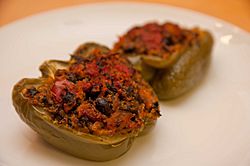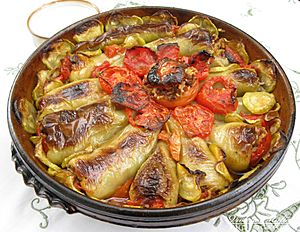Stuffed peppers facts for kids
 |
|
| Main ingredients | Peppers |
|---|---|
Stuffed peppers are a yummy dish found in many cuisines around the world. They are made by taking peppers, hollowing them out, and filling them with tasty things. These fillings often include meat, vegetables, cheese, rice, or different sauces. Once filled, the peppers are cooked until they are soft and delicious.
Contents
Stuffed Peppers Around the World
Stuffed peppers are popular in many countries, each with its own special way of making them. Let's explore some of these delicious variations!
Stuffed Peppers in Spain
In Spain, stuffed peppers are called pimientos rellenos. They are a traditional food, especially in the Basque Country region. People often use piquillo peppers for this dish. Fillings can be Manchego cheese, chicken, or cod fish in a red sauce. Chicken is probably the most popular filling.
Stuffed Peppers in India
In India, stuffed peppers are known as Bharvan Mirch or Bharva Hari Mirch. They are one type of 'Bharvan subji', which means stuffed vegetables. Bell peppers are filled with cooked meat, potatoes, and onions. They are seasoned with spices like chili, turmeric, coriander, and cilantro, plus salt and lemon juice. The peppers are then cooked in a frying pan or baked until they are a bit browned.
Another popular pepper dish in India is Mirchi bajji or pakora. This is a type of chaat (street food) that people love during the rainy and cooler months. In Mumbai, large green chili peppers are stuffed with a spiced flour mix and then fried. In southern India, big green chilies are dipped in a flour batter and fried. These are often served with chutneys and sauces. Smaller, spicier chilies are also stuffed and fried, especially to eat with rice.
Stuffed Peppers in Post-Ottoman Countries
Dolma is a group of stuffed dishes that came from Ottoman cuisine. These dishes can be served warm or cold. Some types of dolma use whole vegetables, including whole peppers. Today, you can find dolma in the foods of the Balkans, South Caucasus, Central Asia, and the Levant. The word "dolma" comes from the Turkish word for "something stuffed."
Stuffed Peppers in North America
In American cuisine, stuffed peppers often use bell peppers, which can be green, yellow, orange, or red. These peppers are usually filled with ground beef mixed with bread crumbs or cooked rice, eggs, herbs, and spices like paprika and parsley. They often have cheese on top. Recipes can be different, but usually, the peppers are hollowed out, sometimes boiled, then stuffed, covered with cheese, and baked. They can also be cooked slowly on the stove in tomato sauce until they are soft.
Mexican cuisine also has several stuffed pepper dishes:
- The Chile relleno means "stuffed pepper." It is made with a roasted green Pasilla or poblano pepper. This pepper is stuffed with cheese (often queso fresco) or sometimes minced meat. It is then covered in an egg batter and fried. It is often served with a sauce. Sometimes, it is put into a taco with rice, salsa, and other toppings. This dish is also popular in Tex-Mex restaurants in the southwestern U.S., where cheddar cheese is often used instead of queso fresco.
- Jalapeño poppers are jalapeño peppers that have been hollowed out. They are stuffed with a mix of cheese, spices, and sometimes ground meat. Then, they are deep-fried until crispy.
Stuffed Peppers in Guatemala
In Guatemala, the "pimiento" pepper is stuffed with shredded pork and vegetables. Like the Mexican version, it is covered with egg batter and fried. It is served with tomato sauce or inside a bread bun.
Stuffed peppers are also popular in Scandinavian countries and the Baltic countries.
- In Scandinavian countries, they are called:
- In Baltic countries, they are called:
- Kimšti pipirai (Lithuanian) – often made with ground beef or pork, rice, vegetables, and spices.
- Pildīti pipari (Latvian)
- Täidisega paprika (Estonian) – these names simply mean "stuffed peppers."
Stuffed Peppers in Central and Southeast Europe
There are many names for stuffed peppers in the languages of Central and Southeast Europe:
- Filana paprika or Punjena paprika (Croatian)
- Speca të mbushur (Albanian)
- Filovana paprika (Bosnian)
- Пуњена паприка (Serbian)
- Polnjena paprika (Slovenian)
- Faszerowana papryka (Polish)
- Gefüllte Paprika (German)
- Töltött paprika (Hungarian)
- Полнети пиперки (Polneti piperki) (Macedonian)
- Plněná paprika (Czech)
- Plnená Paprika (Slovak)
- Пълнени чушки (Pulneni chushki) (Bulgarian)
- Фарширований перець (Ukrainian)
- Ardei umpluți (Romanian)
In all these languages, the name means something like "filled peppers." This dish is very popular in the Zagorje and Vojvodina regions, and it has been influenced by Hungarian cooking. The filling usually has ground meat, like beef, mixed with herbs, spices, and rice. In Bulgaria, people often eat stuffed peppers with yogurt. Another type of Bulgarian stuffed pepper uses a mix of white cheese and eggs instead of meat and rice.
In Romanian cuisine, stuffed peppers are usually made with bell peppers filled with ground meat (often pork), rice, onion, and other vegetables and spices. They are then boiled in a sauce made from cream, tomatoes, and spices.
Stuffed peppers are also a popular dish among Romani people and are a part of Romani cuisine.
See also
 In Spanish: Pimientos rellenos para niños
In Spanish: Pimientos rellenos para niños




